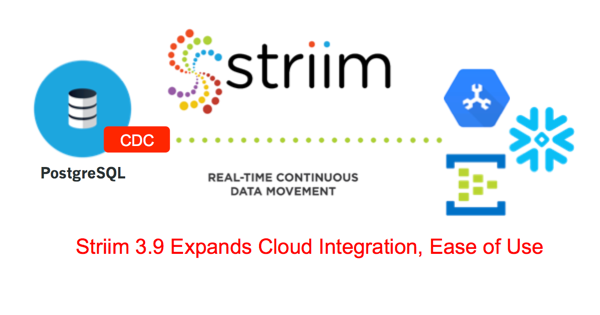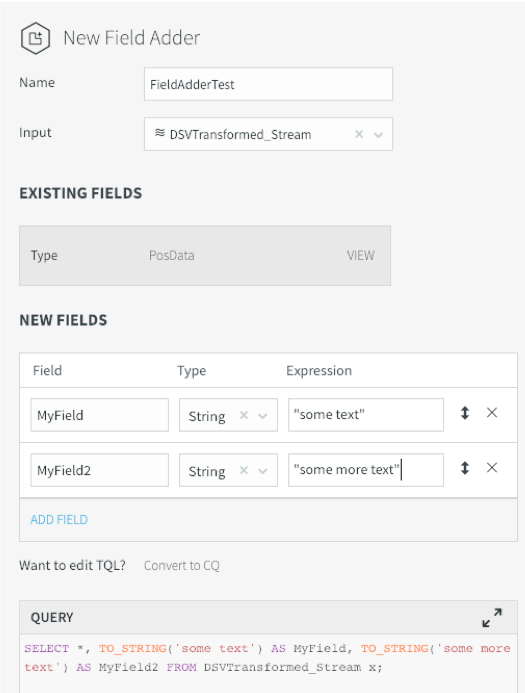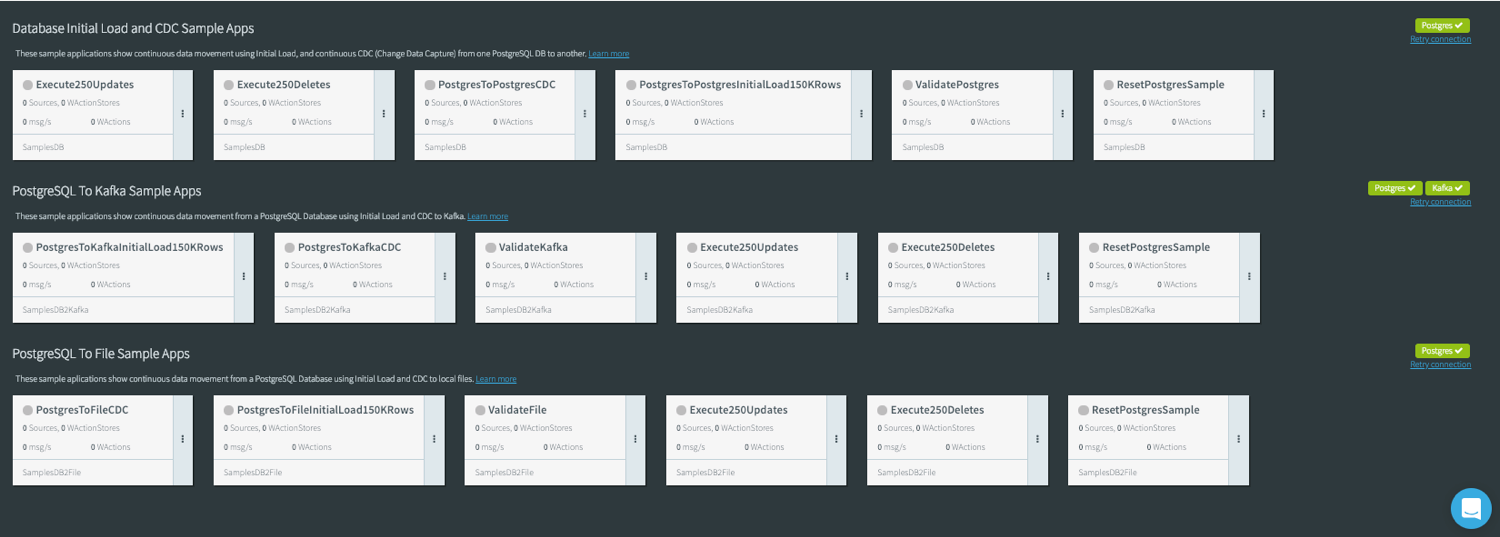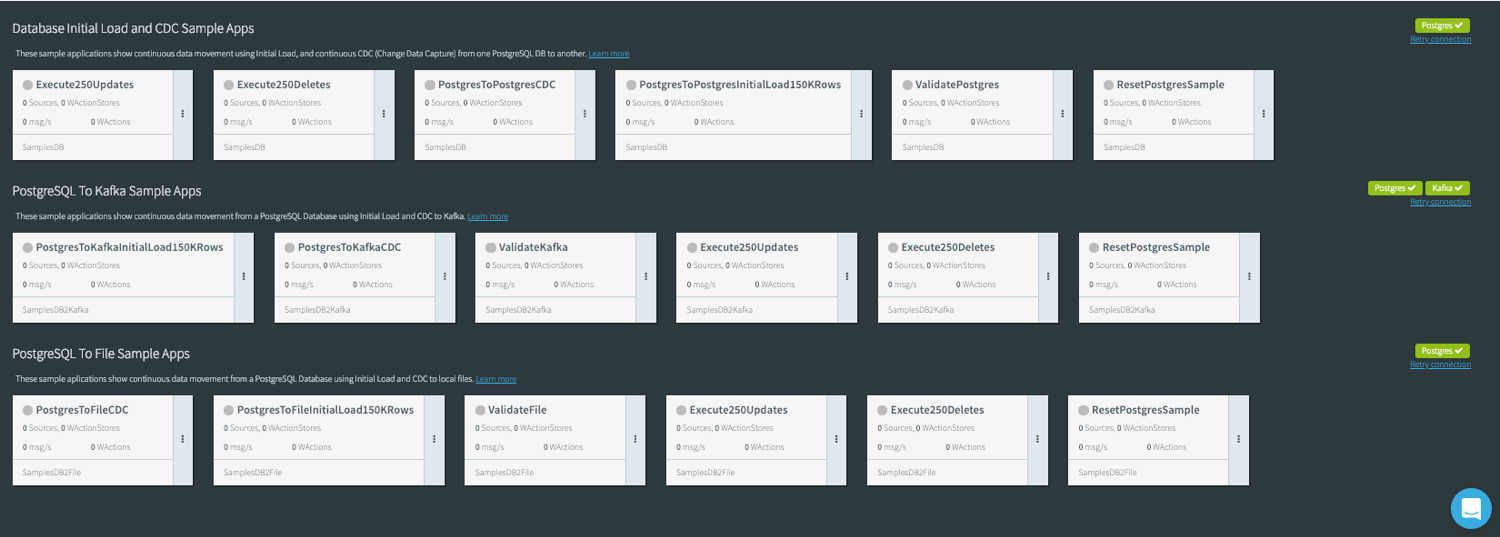Striim 3.9 expands cloud integration capabilities and ease-of-use to support faster time-to-market for stream data integration applications. In this blog post, I would like to walk you through the key new features we introduced. Let’s start with the new cloud integration offerings.
Expanded Cloud Integration Solutions and Partnerships
Striim 3.9 supports streaming integration for new cloud solutions to enable businesses to easily extend their data infrastructure to hybrid and multi-cloud architectures by moving enterprise data in real time between on-premises and major cloud environments. The new release includes real-time data delivery to Snowflake, Google Spanner, Azure Event Hubs, and real-time change data capture from PostgreSQL databases, deployed on-premises or in the cloud.
- Direct Writer for Snowflake Integration: By streaming enterprise data to Snowflake with built-in scalability, security, and reliability, Striim 3.9 simplifies adopting a modern, cloud data warehouse in the cloud for time-sensitive, operational decision making. Using Striim’s streaming ETL capabilities Snowflake customers can ingest a wide range of real-time data — from enterprise databases, security and other systems’ logs, sensors, Kafka and Hadoop — in a consumable form to enable rich analytics and build an operational data warehouse in the cloud. Striim’s low-impact, real-time CDC from data warehouses (including Oracle Exadata, Teradata, Amazon Redshift), databases (including Oracle, SQL Server, HPE NonStop, MongoDB, Amazon RDS, MySQL, and PostgreSQL) enables Snowflake customers to have low-latency enterprise data in their analytics solutions.
- New Writer for Google Cloud Spanner Database. Striim offers a new platform as a service (PaaS) solution for real-time data integration to Google Cloud Spanner, available in the Google Cloud Platform (GCP) marketplace. Striim’s Real-Time Data Integration to Cloud Spanner offers zero-downtime, zero-data-loss data migration, as well as ongoing real-time data loading, through comprehensive streaming data integration capabilities.
With Striim, Cloud Spanner users can quickly build highly reliable, scalable, and performant real-time data pipelines from on-premises and other cloud environments. Using non-intrusive, real-time change data capture (CDC), Striim continuously replicates transactions in other relational databases to Cloud Spanner with no performance impact or operations interruption.
Cloud Spanner users require smooth, low-risk database migration to support mission-critical applications. Striim’s real-time data migration capabilities enable Cloud Spanner customers to move data from existing on-premises or cloud-based relational databases (such as Oracle, SQL Server, HPE NonStop, MySQL, PostgreSQL) without database downtime or data loss.
- Direct Writer for real-time data delivery to Azure Event Hubs: Striim 3.9 supports direct integration to Microsoft Azure Event Hubs in real time. Azure Event Hubs helps companies feed real-time data to a variety of Azure services and applications that run on Azure. With Striim, Azure users can continuously move data to Azure Event Hubs, transforming and processing the data while it is streaming. By setting up real-time data pipelines into Event Hubs using Striim, Azure users can ingest real-time, pre-processed data from on-premises or cloud-based databases, log files, sensors, Kafka, Hadoop, and NoSQL databases without impacting the source systems. With this high-speed, highly consumable data, Event Hubs users can rapidly deploy applications on Azure that use real-time enterprise data, regardless of where the data resides.
- Low-impact, log-based CDC from PostgreSQL: Striim 3.9 expands its support for low-impact change data capture by adding PostgreSQL, for versions 9.4 and after, as a source to its list of databases. As a popular open source object-relational database system, PostgreSQL handles both analytical and transactional workloads. By ingesting data from PostgreSQL in real time without impacting its performance, Striim enables both continuous, real-time data pipelines and zero downtime data migration from PostgreSQL on-premises or in the cloud, to cloud-based transactional or analytical environments. With Striim’s support for a wide range of cloud and on-premises solutions, organizations can easily adopt multi-cloud architectures, such as moving real-time data from Amazon PostgreSQL to Snowflake data warehouse on Azure or Google BigQuery.
- Enhanced security and authentication for AWS environments: Striim 3.9 now offers advanced security protocols to better support integration with S3, Kinesis, Redshift services. Striim 3.9 includes role-based authorization and access for S3, Kinesis, Redshift integration solutions by integrating with AWS’s Identity and Access Management (IAM) service.
Ease of use
Striim 3.9 offers several new features that make it even easier to deploy Striim applications and monitor data pipeline health with real-time alerts. Striim customers can quickly set up new applications, transform and enrich data flows without coding via the drag and drop UI, receive comprehensive pipeline health reports with historical and real-time data, and quickly set up application level real-time notifications on pipeline health to support continuous operations.
- A New Library of Transformers and Enrichment Components: To support a broad range of users that prefer zero coding environment, Striim 3.9 now offers a comprehensive set of transformers for adding, removing, masking, and manipulating data fields via the drag-and-drop UI. Striim users can now design a data flow with various essential transformations and enrichments by selecting the component from the UI and easily configuring it on the Flow Designer window without any coding. The availability of a rich set of transformation and enrichment components significantly reduces design and development time and accelerates time-to-market for Striim applications. Striim’s SQL-based processing interface is still accessible for power users to support more complex transformations.
- Container with 13 Pre-Configured Starter Integration Applications: Striim 3.9 ships with a container image and pre-connected, pre-configured data flows for PostgreSQL to PostgreSQL, PostgreSQL to Kafka, and PostgreSQL to files integration use cases. The applications enable initial load, log-based change data capture, and delivery validation and help users get started with Change Data Capture (CDC) use cases easily and rapidly in just a few seconds. These 13 starter applications also serve as templates for other database sources such as Oracle, SQL Server, MySQL, HPE NonStop, significantly decreasing the design and deployment timeframe for real-time data pipelines.
- Improved Pipeline Health Monitoring with Reports: Viewable via the Striim UI directly or via Rest API, these reports on past data movement activity help users identify key trends as they relate to their data pipelines to optimize their data flows. The reports include aggregate information such as the number of events processed, number of continuous queries, number of events in time windows, for a specified period.
- Advanced Alerting at Pipeline Level for Continuous Operations: With Striim 3.9 users can set alerts through the Flow Designer at the application or data pipeline level. The expanded alert function simplifies operational alert configuration by eliminating manual set up requirements. By providing real-time notification on pipeline events, this new alerting feature supports continuous uptime of Striim applications.
For a technical overview of all of the features included in Striim 3.9, I invite you to request a customized demo. If you would like to check out any of these features for yourself, please download a free trial.
























